The first time I witnessed a grown man weep over a bowl of pasta, it wasn’t at some Michelin-starred Italian restaurant. It was in my own kitchen, watching my Philadelphia-born sous chef taste what we’d been experimenting with for weeks—a perfect marriage between the City of Brotherly Love’s most iconic sandwich and Italy’s gift to the world. That’s the power of Philly Cheesesteak Pasta, a dish that shouldn’t work on paper but creates pure magic on the palate.
This isn’t just another fusion experiment gone wrong. It’s a thoughtful translation of flavors, textures, and cultural soul food into something entirely new yet familiar. Every component of the classic Philly cheesesteak finds its way into this pasta, from the paper-thin ribeye to the sweet caramelized onions, all bound together with a cheese sauce that would make Pat’s and Geno’s customers question their loyalties.
What Makes This Recipe Special
Philly Cheesesteak Pasta represents more than culinary creativity—it’s a masterclass in flavor adaptation. The genius lies in maintaining the sandwich’s essence while leveraging pasta’s superior ability to hold and distribute flavors. Where a hoagie might lose its structural integrity after a few bites, pasta creates the perfect vehicle for capturing every drop of that rich, meaty sauce.
The technique behind this dish borrows from both Italian pasta-making traditions and American comfort food sensibilities. We’re not simply throwing ingredients together; we’re building layers of flavor that complement and enhance each other. The key is understanding how each element contributes to the whole, rather than treating it as seperate components fighting for attention.
Ingredients & Substitutions
Primary Ingredients
For the Pasta Base:
- 1 pound rigatoni or penne pasta (the ridges are essential for sauce adherence)
- 1.5 pounds thinly sliced ribeye steak, cut against the grain
- 2 large yellow onions, sliced thin
- 1 large green bell pepper, julienned
- 8 oz mushrooms, sliced (optional but recommended)
For the Cheese Sauce:
- 8 oz cream cheese, room temperature
- 1 cup whole milk
- 8 oz sharp provolone cheese, grated
- 4 oz American cheese, cubed
- 2 tablespoons butter
- 2 cloves garlic, minced
- 1 teaspoon Worcestershire sauce
- Salt and freshly cracked black pepper to taste
Smart Substitutions
When ribeye becomes prohibitively expensive, sirloin or even well-marbled chuck eye steak work beautifully—just ensure you slice them paper-thin against the grain. The secret is in the cutting technique, not necessarily the premium cut. For those watching their budget, even a good quality deli roast beef, chopped fine, can deliver surprising results.
Cheese substitutions require careful consideration. The combination of provolone and American isn’t arbitrary—provolone provides sharp, nutty complexity while American contributes that signature creamy melt. If provolone isn’t available, aged white cheddar works, though you’ll lose some authenticity. Never substitute the American cheese with something “fancier”—its emulsifying properties are crucial for achieving that perfect sauce consistency.
For pasta selection, shape matters enormously. Rigatoni’s large tubes and ridged exterior create ideal pockets for the cheese sauce and small pieces of meat. Penne works as a backup, but avoid smooth pasta shapes like pappardelle or fettuccine—they simply can’t hold the robust ingredients effectively.
Step-by-Step Instructions
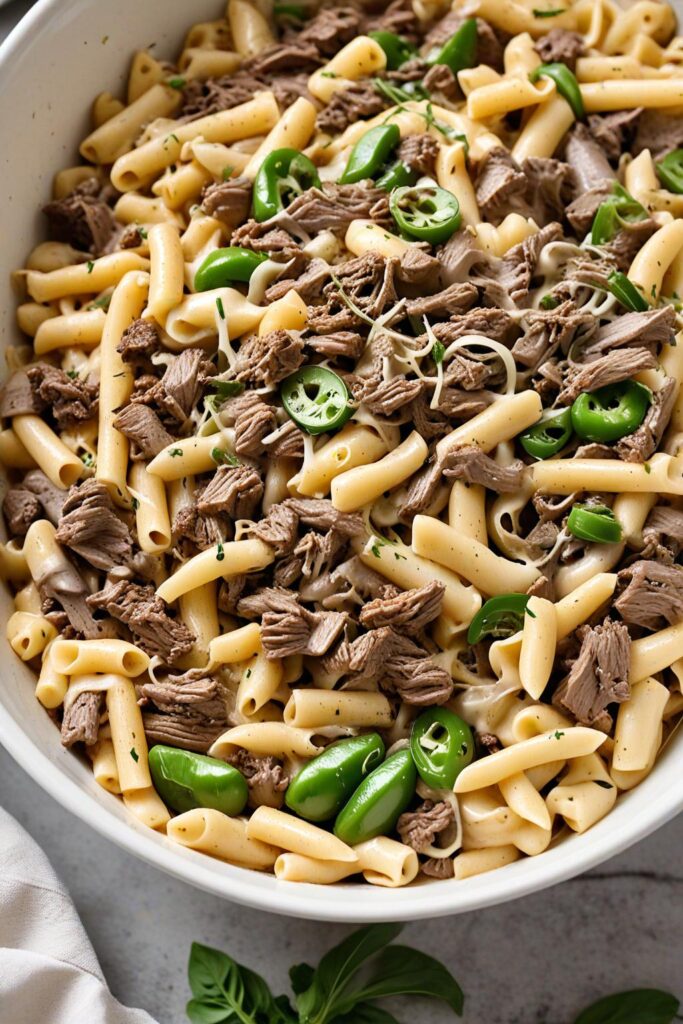
Preparation Phase
Begin by bringing a large pot of generously salted water to a rolling boil. The water should taste like the sea—this is your only opportunity to season the pasta itself. While waiting for the boil, slice your ribeye into the thinnest possible strips, working against the grain. If the meat is slightly frozen, it’ll slice more cleanly and evenly.
Heat a large, heavy-bottomed skillet or Dutch oven over medium-high heat. Add a splash of neutral oil with a high smoke point—avoid olive oil here, as we need serious heat without burning. The pan should be large enough to eventually hold all ingredients comfortably; overcrowding kills the development of proper flavors.
Building the Foundation
Cook the sliced onions first, allowing them to caramelize slowly over medium heat. This process takes patience—rushing it with higher heat produces burned outsides and raw centers. Properly caramelized onions develop deep, sweet notes that become the flavor backbone of the entire dish. They’re ready when they’ve reduced significantly and achieved a deep golden-brown color, usually 15-20 minutes.
Add the bell peppers to the caramelized onions, cooking until they’re just tender but still retain slight bite. Mushrooms, if using, go in next. The key is managing moisture—each vegetable releases water, and we want evaporation, not steaming. Season lightly with salt to help draw out moisture and concentrate flavors.
The Meat Element
Push vegetables to one side of the pan and increase heat to high. Add the sliced ribeye in a single layer, working in batches if necessary. Avoid the temptation to move or stir the meat immediately—let it develop a proper sear. The goal isn’t full cooking but rather developing color and flavor while keeping the interior tender.
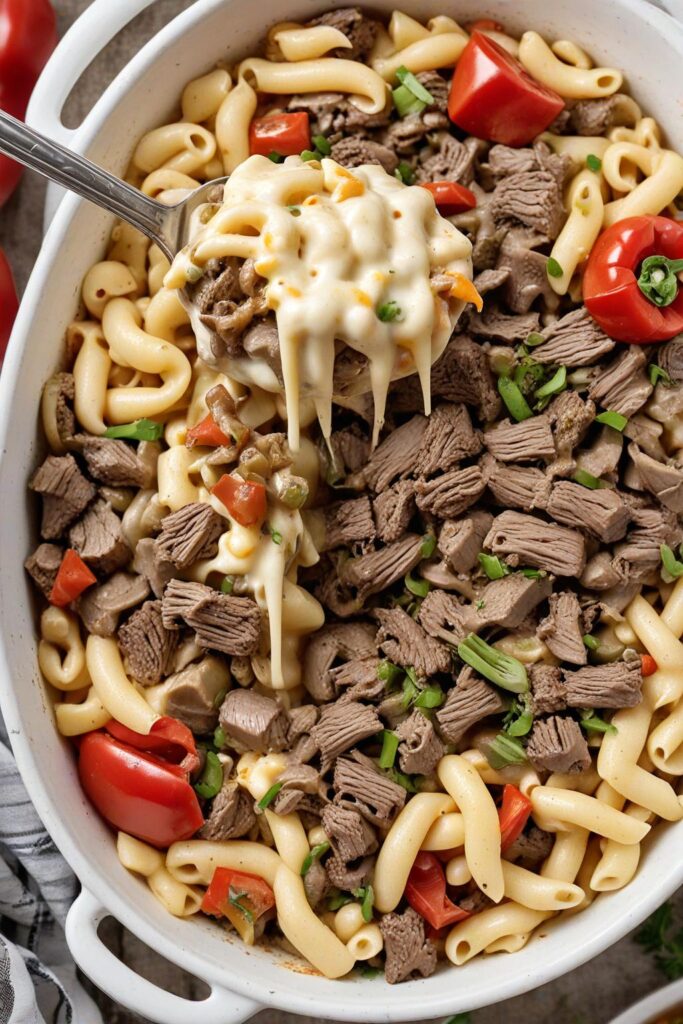
Season the meat with salt and pepper during cooking. The high heat and thin slicing means the beef cooks incredibly quickly—usually just 2-3 minutes total. Overcooked cheesesteak meat becomes tough and chewy, destroying the dish’s appeal. Remove the meat to a plate while you build the sauce.
Creating the Cheese Sauce
Lower the heat to medium-low and add butter to the same pan, using the fond (those browned bits) from the meat and vegetables. Add minced garlic, cooking just until fragrant—about 30 seconds. Overcooked garlic becomes bitter and overpowering.
Add cream cheese to the pan, allowing it to melt slowly while whisking constantly. Room temperature cream cheese incorporates much more smoothly than cold. Gradually add the milk, whisking continuously to prevent lumps. The mixture should be smooth and beginning to bubble gently around the edges.
Add the grated provolone first, whisking until completely melted before adding the American cheese cubes. American cheese can be temperamental—add it off the heat if necessary to prevent separation. The sauce should be creamy and coat the back of a spoon. Add Worcestershire sauce and season carefully with salt and pepper.
Bringing It Together
By now, your pasta should be cooking. Follow package directions but test for doneness a minute early—the pasta will finish cooking in the sauce. Reserve 1 cup of pasta water before draining; this starchy liquid is crucial for adjusting sauce consistency.
Return the cooked vegetables and meat to the cheese sauce, stirring gently to combine. Add the drained pasta, tossing everything together with pasta tongs or two large spoons. If the mixture seems too thick, add pasta water gradually until you achieve the perfect consistency—creamy but not gloppy.
Cooking Techniques & Science
The science behind great Philly Cheesesteak Pasta lies in understanding emulsification and protein behavior. Cheese sauces rely on proper temperature control to maintain smooth texture. Too much heat causes proteins to tighten and separate, resulting in grainy, broken sauces. The combination of cream cheese and American cheese works because cream cheese provides richness and tang while American cheese contributes superior melting properties due to its emulsifying salts.
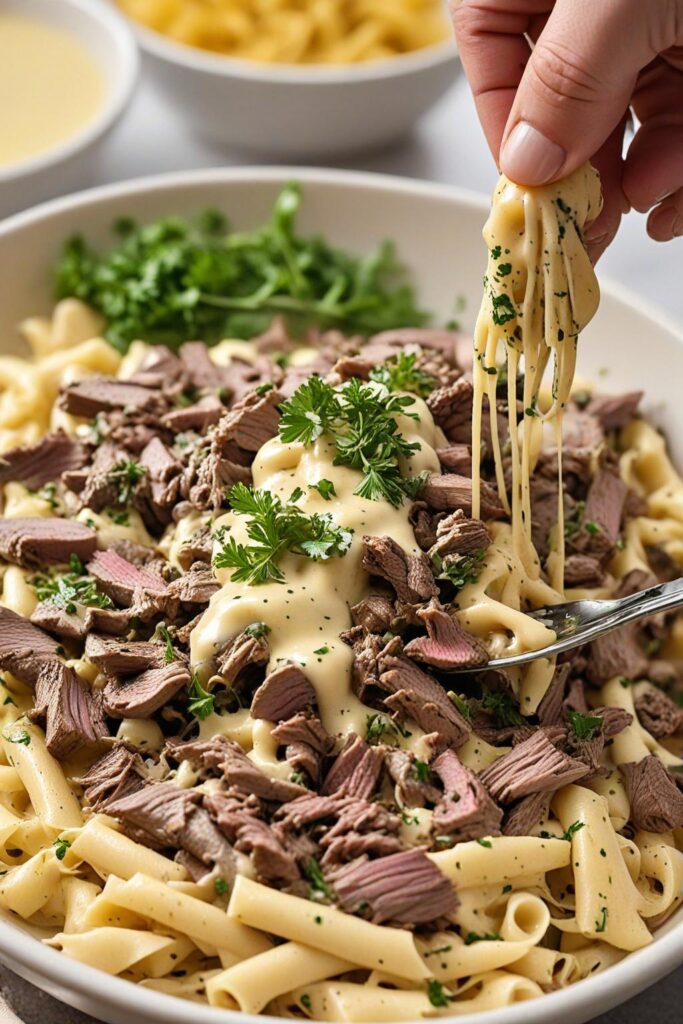
The Maillard reaction plays a crucial role in developing the dish’s complex flavors. When we sear the beef and caramelize the onions, we’re creating hundreds of new flavor compounds through the interaction of proteins, sugars, and heat. This is why proper browning technique cannot be skipped—it’s the difference between good and exceptional results.
Pasta water serves multiple functions beyond just cooking the noodles. The starch-rich water acts as a natural emulsifier, helping bind the sauce to the pasta. It also provides a way to adjust consistency without diluting flavors, as commercial pasta water contains salt and concentrated starches that complement rather than compete with other ingredients.
Advanced Techniques for Professional Results
Temperature control becomes critical when scaling this recipe for larger quantities. Professional kitchens often struggle with cheese sauces because industrial burners run too hot for delicate emulsions. The solution involves creating a water bath effect—placing your sauce pot inside a larger pot with simmering water, maintaining gentle, even heat distribution.
For restaurant service, consider par-cooking components separately and assembling to order. The cheese sauce holds well in a bain-marie, while the meat and vegetables can be portioned and quickly reheated. This approach prevents overcooking and maintains optimal texture for each element.
Mise en place becomes especially important with this recipe. Once you begin cooking, events move quickly, and there’s no time to stop and slice onions or grate cheese. Professional execution demands having every ingredient prepped and within arm’s reach before lighting the first burner.
Serving & Presentation
Plating Philly Cheesesteak Pasta requires restraint—the temptation is to pile it high, but a thoughtful presentation elevates the entire experience. Use warmed bowls to prevent the cheese sauce from cooling too quickly. A wide, shallow bowl shows off the pasta’s texture better than a deep soup bowl.
Garnish possibilities include finely chopped fresh parsley for color contrast, a light dusting of freshly grated Parmigiano-Reggiano for extra umami depth, or even a few drops of good hot sauce for heat. Some chefs finish with a drizzle of high-quality olive oil, though this moves away from the dish’s American comfort food roots.
Consider serving alongside simple sides that won’t compete with the pasta’s richness. A crisp arugula salad with lemon vinaigrette cuts through the heaviness beautifully. Garlic bread seems obvious but risks redundancy—instead, try toasted sourdough points for textural contrast without overwhelming carbohydrates.
Pairing Suggestions
Wine pairing with Philly Cheesesteak Pasta challenges conventional wisdom. The dish’s richness and American cheese components don’t naturally align with traditional Italian wine pairings. Instead, consider medium-bodied red wines with good acidity—a Sangiovese or Chianti Classico provides enough structure to cut through the richness while complementing the beef elements.
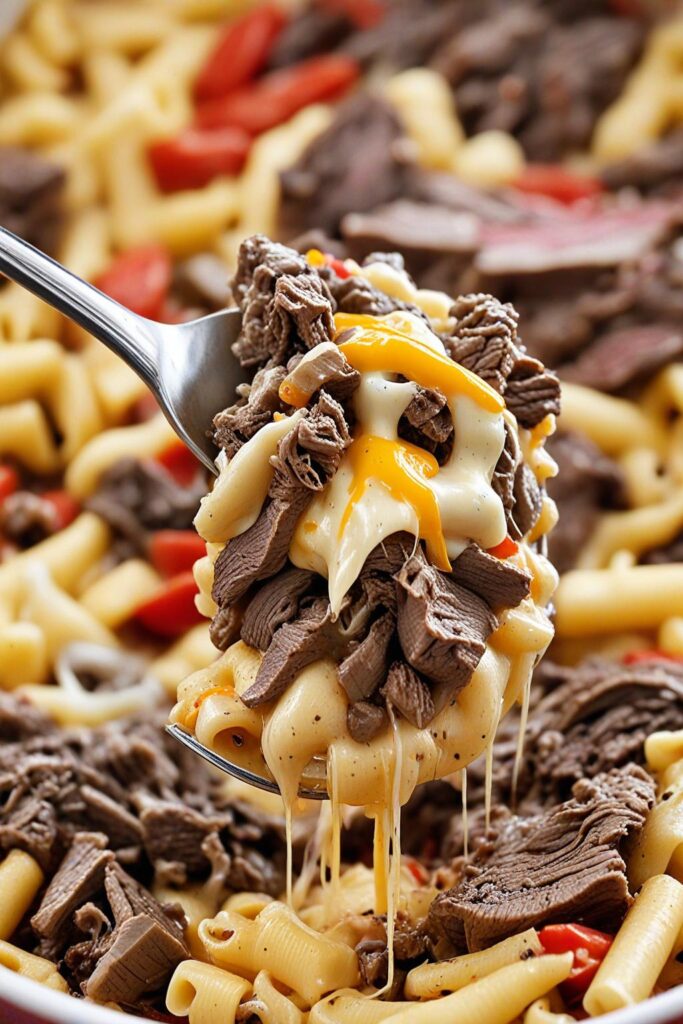
For beer enthusiasts, this dish shines alongside Philadelphia’s local brewing tradition. A crisp lager like Yuengling provides palate-cleansing bubbles, while an IPA’s hop bitterness balances the cheese sauce’s richness. Avoid overly heavy or sweet beers that would compete rather than complement.
Non-alcoholic options benefit from brightness and acidity. Sparkling water with fresh lemon, unsweetened iced tea, or even a well-made lemonade provide the acidic contrast needed to balance the dish’s richness. The goal is cleansing the palate between bites, not competing with flavors.
Troubleshooting Common Issues
Broken cheese sauces represent the most frequent failure point. If your sauce separates or becomes grainy, remove it from heat immediately and whisk in cold milk or pasta water, one tablespoon at a time. Sometimes adding a small amount of cold butter while whisking vigorously can re-emulsify a broken sauce.
Overcooked meat ruins the entire dish’s texture and appeal. If you suspect the beef is overcooked, remove it from the pan immediately and consider starting over with fresh meat. There’s no recovery technique for tough, overcooked steak strips—prevention through careful temperature control and timing is the only solution.
Pasta consistency problems usually stem from incorrect pasta water starch levels or insufficient reserved cooking liquid. Next time, reserve more pasta water and add it gradually while tossing. The sauce should coat each piece of pasta without pooling in the bottom of the bowl.
Creative Variations
Regional variations offer exciting possibilities. A Texas interpretation might include jalapeños and pepper jack cheese, while a California version could incorporate sun-dried tomatoes and fresh basil. Each variation should maintain the dish’s core identity while reflecting local preferences and available ingredients.
Protein substitutions open additional avenues for creativity. Chicken thighs, sliced thin and properly seasoned, create a lighter version while maintaining the dish’s hearty character. Even high-quality deli turkey, when properly prepared, can work for those avoiding red meat entirely.
Vegetarian versions require more creativity but aren’t impossible. Thick-sliced portobello mushrooms, properly seared and seasoned, provide meaty texture and umami depth. The cheese sauce remains unchanged, maintaining the dish’s essential character while accommodating dietary restrictions.
Final Expert Tips
Timing coordination separates successful execution from kitchen chaos. Start the pasta water first, then begin vegetable prep while it heats. The pasta should go into the water just as you begin cooking the meat—this synchronization ensures everything finishes simultaneously without components sitting and deteriorating.
Quality ingredients make an enormous difference in the final result. Invest in good cheese, properly aged and freshly grated. Pre-shredded cheese contains anti-caking agents that interfere with smooth sauce formation. The extra effort of grating fresh cheese pays dividends in texture and flavor.
Finally, taste and adjust constantly throughout the cooking process. Salt levels, cheese balance, and sauce consistency all benefit from continuous evaluation and adjustment. Professional cooking involves constant tasting and tweaking—trust your palate over rigid adherence to recipes.
This dish represents the best of American fusion cuisine—taking beloved flavors and reimagining them in new forms while respecting their origins. When executed properly, Philly Cheesesteak Pasta delivers the comfort and satisfaction of its namesake sandwich while offering the sophistication and flexibility that only pasta can provide.
Frequently Asked Questions?
Can I make this dish ahead of time?
Philly Cheesesteak Pasta reheats reasonably well but never quite matches fresh preparation. If you must make it ahead, undercook the pasta slightly and store components separately when possible. Reheat gently with additional pasta water or milk to restore proper consistency. The cheese sauce tends to thicken considerably when cold, so patience and gentle reheating are essential.
What’s the best way to slice the ribeye so thin?
Partially freezing the ribeye for 30-45 minutes makes slicing much easier and more consistent. Use your sharpest knife and slice against the grain in smooth, confident strokes. If you have access to a deli slicer, that’s ideal, but most home cooks can achieve excellent results with proper knife technique and slightly frozen meat.
Can I substitute the American cheese with something else?
American cheese serves a specific function beyond flavor—its emulsifying properties help create a smooth, stable sauce. While you can substitute other melting cheeses like Velveeta or even extra cream cheese, the texture and mouthfeel will change. Sharp cheddar can work but may result in a slightly grainier sauce that’s still delicious but different from the intended result.
How do I prevent the cheese sauce from breaking?
Temperature control is everything with cheese sauces. Keep heat at medium-low or lower once you add the cheese, and never let the mixture boil vigorously. If the sauce starts to separate, immediately remove it from heat and whisk in cold liquid (milk or pasta water) one tablespoon at a time until it comes back together. Room temperature cream cheese also incorporates much more smoothly than cold.
What pasta shapes work best besides rigatoni?
Look for pasta shapes with ridges, tubes, or other features that grab and hold the sauce. Penne, shells, cavatappi, or even rotini work well. Avoid long, smooth pasta like spaghetti or linguine—they simply can’t hold the chunky sauce effectively. The goal is maximum surface area contact between pasta and sauce for optimal flavor distribution in every bite.
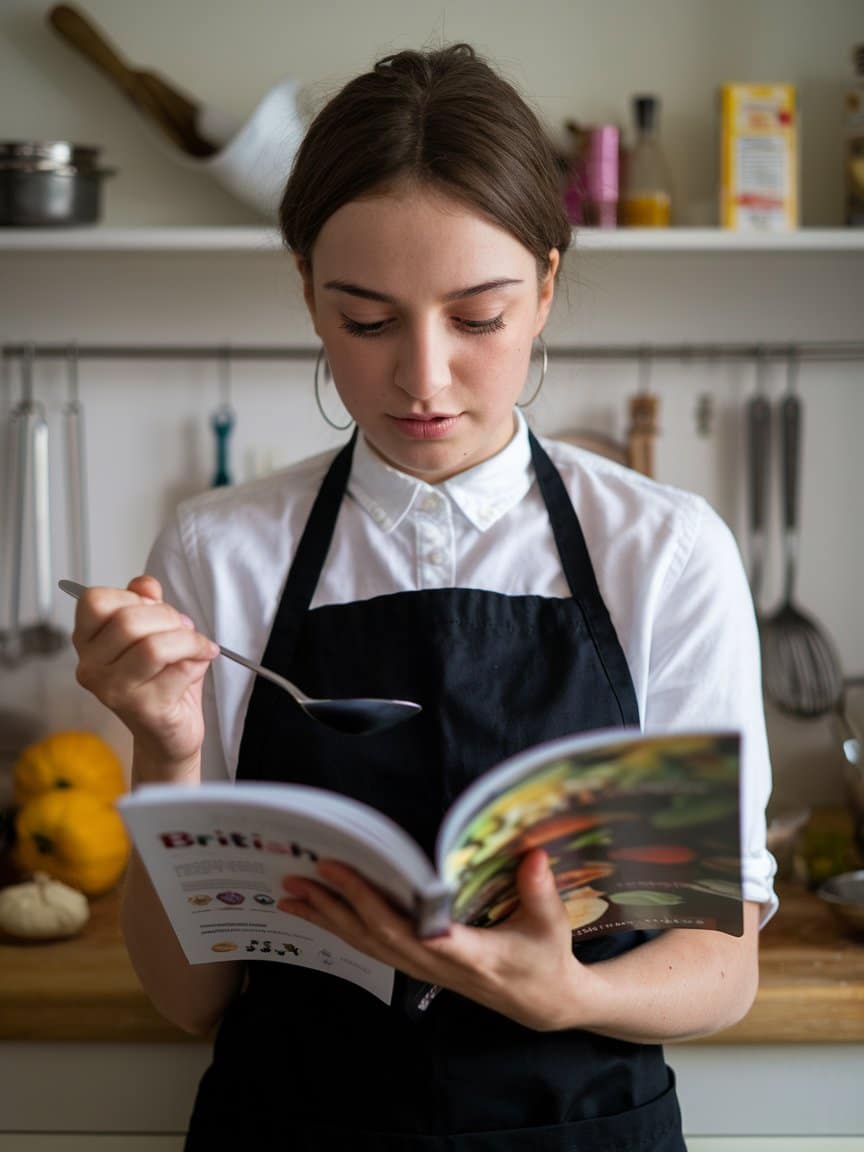
Veronica is a passionate food enthusiast with over three years of experience in exploring and writing about diverse cuisines. Her expertise lies in reviewing restaurants, sharing creative recipes, and discovering the latest food trends. As the voice behind FoodieRecap.com, Anju brings fresh perspectives and culinary insights to her audience.
